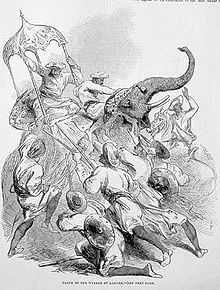Persian war elephants

History
Under the Achaemenids
The Persians are known to have used fifteen war elephants at Gaugamela, but some people[citation needed] claim that they had been used previously in the Greek campaign of king Xerxes I of Persia, and even further back at the time of Darius the Great at the Indus, the Danube and against the Scythians in 512 BC. Neither Xenophon nor Herodotus mention war elephants in their accounts of these earlier campaigns.
Under the Sassanids
.png)
Armenian wars
The most famous was the Battle of Avarayr (Armenian: Ավարայրի ճակատամարտ) in 451 CE, where Armenian rebels led by Vartan Mamikonian led an army of 66,000 men to gain independence from the Sassanids under Yazdegerd II, who opposed them with 300,000 men and war elephants.
Despite their victory over the rebels and the death of their leaders (including Vartan Mamikonian), Yazdegerd's forces gave the Armenians their religious freedom, largely due to the fierce and relentless spirit that they presented in the battle. While they won the battle, Persian forces had a disproportionate number of casualties and deaths compared to the Armenians.
Ghaznavid war elephants
The Ghaznavids used armored war elephants against the Turks of Central Asia and the Hindus of India in the 11th and 12th centuries.[1] Islamic historians record that a standing force of 1000 elephants was maintained at Ghazni (also: Ghazna), the capital, and that as many as 400, 500, or even 700 elephants were deployed in some campaigns by the famed (and ferocious) Mahmud; purportedly, each animal had a crew of four archers and/or spearmen borne in "castle-like" structures on the elephants' backs.
Persians fighting against elephants, 18th Century India
In 1739, Nader Shah of Persia's Afsharid dynasty invaded India and led an army to the capital, Delhi; but he was halted on the way by the Mughul ruler Muhammad Shah and his huge army, which greatly outnumbered the Persian army. The Indians also had war elephants with them; these had blades on their tusks which they had been taught to use against the enemy. Nader Shah is said to have sent pots of oil to the front lines, where the accompanying goats' horns were ordered to be set on fire. The goats charged at the elephants, who panicked and turned around, killing thousands of Indian troops, as reportedly had happened at the battle of al-Qādisiyyah between the Sassanid Persians and the Muslim invaders of their empire in 636 AD. Different authorities claim that Nader Shah ordered camels to be paired together and platforms constructed between them; a mixture of naphtha combustibles was placed on the platforms with orders to set them on fire during the battle so that the Mughal elephants would flee at the sight of the fire and cause mayhem in their own army. In either event, the Mughul elephants apparently proved in this case (the Battle of Karnal) to be a "double-edged sword". Following his defeat of Muhammad Shah, Nader's soldiers carried many elephants home with them to Iran.
Origin and training

Persian war elephants were trained by their rider, called a mahout, who would also ride the elephant into battle. The mahouts were of Indian origin, and so were the archers. Training elephants was a difficult and they would be hard to maintain because they ate so much food and water. On the march, huge paths needed to be cut for the elephants. Many were kept in the shah's menagerie the most famous of which was Khosrau II where he kept a "thousand white elephants."
Weapons
Persian elephants were from Indian origin and were probably armed with Indian styled weapons. The men(excluding the driver) sat in a large tower from which troops would fight. The elephant itself would normally be armed with thin plate armour (the Sassanids used chain mail as well as thin plate armour)and would bear a large crenelated wooden howdah on its back.[2] The troops would be armed with bow and arrows and javelin. The sworn enemy of the Sassanids, the Eastern Roman empire, were terrified by the huge beasts, making them very effective in battle. When they were used at the Battle of al-Qādisiyyah, they came to be known as "double edged weapons". King ( shah ) Yazdgerd III attempted to use war elephants to fight off Arab invaders, however his elephants got sand in their eyes and panicked. They turned around and ran amok, killing their own troops.
Crushing by elephant

Those people that were traitors to the army, enemies of the empire and criminals were crushed by the elephants this way and executed in the age of Sassanids they also used this method of execution for training for battle.[citation needed]
In popular culture
- Shatranj (Persian chess) - which Modern chess has gradually developed from it, same as Indian chess includes the war elephant with the name (fil),meaning elephant in Persian as the bishop.
See also
- War elephant
- Crushing by elephant
- Sassanid army
- History of elephants in Europe
- List of historical elephants
- Military animals
- Cavalry tactics
References
- David Nicolle, Sassanian Armies : the Iranian empire early 3rd to mid-7th centuries AD (Montvert Publishing 1996). ISBN 1-874101-08-6
- Philip Rance, ‘Elephants in Warfare in Late Antiquity’, Acta Antiqua Academiae Scientiarum Hungaricae 43 (2003) 355-384
- Peter Wilcox, Rome's Enemies 3: Parthians and Sassanid Persians (Osprey Publishing 2001). ISBN 0-85045-688-6
Encyclopædia Iranica
External links
- http://www.iranian.com/main/2011/jul/ancient-world-war-0
- http://www.iranchamber.com/history/parthians/parthians.php
- http://www.artarena.force9.co.uk/sass2.htm